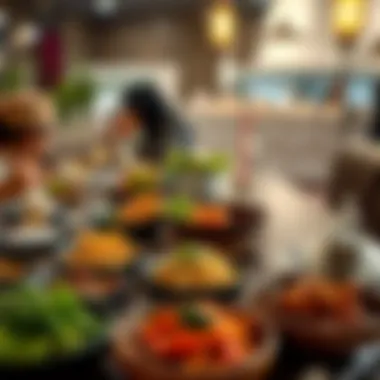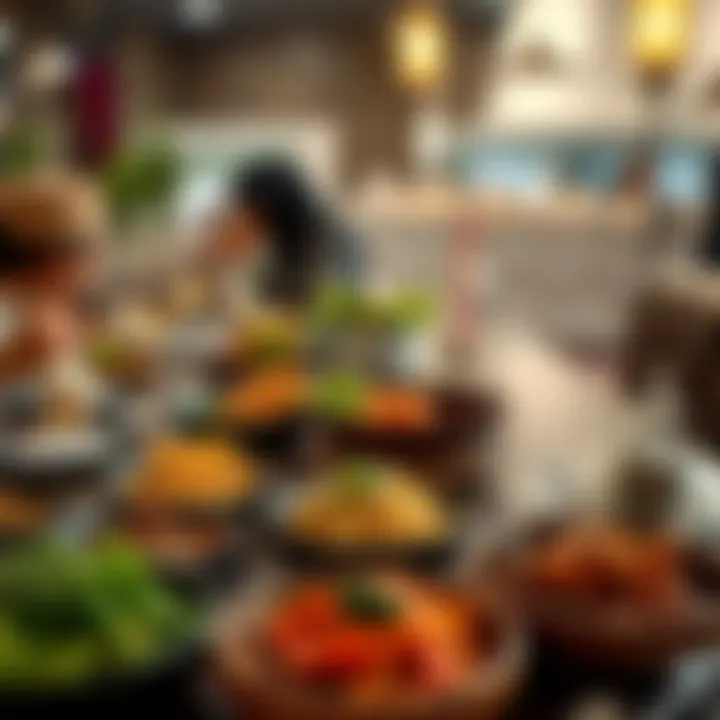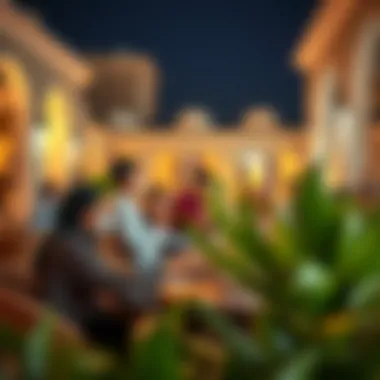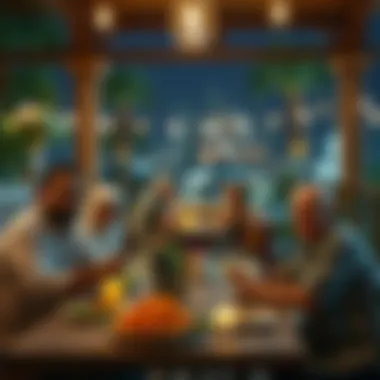Ramadan Iftar Timing 2023: Insights and Variations


Intro
Ramadan is a month filled with spiritual significance for millions of Muslims around the globe. The daily fast, which stretches from dawn until sunset, culminates in a moment of joy known as iftar, the evening meal when the fast is broken. In 2023, understanding the timing of iftar across various regions and cultures is essential not just for those observing Ramadan, but also for communities that come together to celebrate this sacred tradition.
Throughout this guide, we will delve into the subtleties of iftar timings, taking into account geographical variations, cultural practices, and the calculations required to determine the optimum moment to break the fast. We will also touch upon the communal and spiritual dimensions linked to iftar, as families gather around the table, sharing not just food but also rituals and traditions that strengthen familial bonds and foster community spirit. This narrative aims to illuminate how iftar contributes to the overall experience of Ramadan, portraying it as a time of reflection, gratitude, and connection.
By exploring the core aspects of iftar timing, we seek to provide readers with a comprehensive understanding of its role and significance. This isn't just a guide for fasting individuals, but a resource for anyone interested in the cultural fabric of Ramadan. Together, we will navigate the timing spectrum, celebrate the diversity of practices, and appreciate the profound meanings behind every morsel shared at sunset.
Understanding Ramadan
Ramadan stands as a cornerstone in the Islamic calendar, marking a month-long period of fasting, reflection, and community. Understanding Ramadan is crucial not just for Muslims, but for anyone interested in the cultural and social dynamics of diverse communities around the world. This article aims to explore the significance of Ramadan, the principles that guide its observance, and the variations in practices across different cultures.
Significance of Ramadan
The significance of Ramadan extends beyond just abstaining from food and drink from dawn until sunset. It serves as a time for spiritual rejuvenation, introspection, and heightened awareness of one’s place in the world. As the Quran states, Ramadan is a month during which the holy text was first revealed, thus anchoring its status in Islamic belief. Many take this period as an opportunity to strengthen their relationship with the divine, seeking forgiveness and mercy. It is a time to reflect on one's intentions, elevate one’s compassion for others, and, importantly, to empathize with those who suffer from hunger and poverty.
Basic Principles and Practices
Fasting during Ramadan is one of the Five Pillars of Islam, which are fundamental acts of worship. The primary practice involves fasting from sunup to sundown, which includes abstaining from food, drink, smoking, and marital relations. Many Muslims also engage in increased prayer and recitation of the Quran during this month to immerse themselves deeper into their faith.
The fast is broken each evening with a meal known as iftar, traditionally beginning with the consumption of dates and water, which holds both nutritional and spiritual significance. This practice serves as a communal moment when families and friends gather to share the meal.
"Fasting is not just the absence of food and drink; it’s a presence of spirit and community that binds believers together.”
Cultural Variations
Ramadan is observed worldwide, yet the cultural expressions of this sacred month vary significantly across regions. In the Middle East, for example, the iftar meal often features rich dishes, while in South Asia, it may include items like samosas and biryanis. Each culture adds its unique twist, ensuring that while the principles of fasting remain constant, the way people celebrate and experience Ramadan reflects local customs.
In Western countries, the community celebrations might include public iftars, where diverse groups come together to share food and experiences, fostering interfaith dialogues. It's these cultural variations that enrich the global tapestry of Ramadan, highlighting the adaptability of faith to different contexts and environments.
Understanding lead us to appreciate the depth of Ramadan and its role not just as a religious observance, but as a vital community builder that unites people across boundaries.
Iftar: The Meal That Breaks the Fast
Iftar holds a special place in the hearts and minds of Muslims around the world during the holy month of Ramadan. It is not merely a meal but a significant event that symbolizes the end of a day-long fast. Understanding its profound importance sheds light on not just the spiritual aspects, but also the traditions, communal feel, and the flavors that make Iftar an extraordinary experience.
Definition and Importance of Iftar
At its core, Iftar refers to the meal consumed by Muslims after sunset during Ramadan. Experienced each evening, this meal is essentially a reward for the day's fast, a moment of joy and gratitude. The importance of Iftar transcends physical nourishment; it highlights discipline and spiritual dedication. When the call to prayer sounds, signaling sunset, families gather to break their fast. This usually starts with the consumption of water and dates, a practice rooted in the traditions of the Prophet Muhammad.
The essence of Iftar lies in its communal aspect. It serves as a reminder of the importance of unity and sharing. As individuals feast together, bonds are strengthened. Thus, Iftar is not just about satisfying physical hunger but also about fulfilling a spiritual need for connection.
Traditional Foods for Iftar
Typical Iftar meals vary widely across cultures, showcasing an array of ingredients and culinary practices. In the Middle East, it’s common to find dishes like samosas, hummus, and tabbouleh, all beautifully presented. In South Asia, the aroma of biryani, chicken curry, or chole bhature electrifies the air. Meanwhile, in Western countries, the Iftar table might be adorned with a fusion of traditional foods alongside contemporary dishes.
Some staple items, regardless of the region, often make an appearance:
- Dates: Often the first food to be consumed, dates provide a quick source of energy.
- Soups: Lightweight but nourishing, soups like harira or lentil soup are popular choices.
- Salads: Fresh ingredients like cucumbers, tomatoes, and greens help in hydration and provide a refreshing contrast to heavier dishes.
- Desserts: Sweet treats such as baklava or kheer often accompany the meal, sealing the occasion with a sweet note.
Family and Community Gathering
Beyond its culinary significance, Iftar serves as a catalyst for family and community bonding. As families and friends gather, the meal transforms into a shared experience filled with laughter, stories, and togetherness. There’s a sense of joy in sitting down with loved ones after a day of fasting, embracing the moment of breaking bread together.


During this time, you may also find communal Iftar events organized. These gatherings are often hosted by mosques or local community organizations, where dozens if not hundreds come together to share in the bounty. Not only does this foster a sense of belonging, but it also strengthens social ties within diverse communities, offering a space where individuals can connect and share their experiences during this sacred month.
In essence, Iftar is much more than just a meal. It embodies the spirit of Ramadan, enhancing the feelings of gratitude and charity, further emphasizing the bonds of kinship and community. As we observe this special part of the month, let us not forget the nuances that make it a cherished tradition for families around the world.
Iftar Timing Calculations in
Understanding and calculating iftar timings is crucial during Ramadan as it marks the moment Muslims break their fast after a long day. The timing can differ based on various factors, affecting not just individual practices but community gatherings as well. By grasping these calculations, individuals can harmonize their schedules, ensuring they savor the experience alongside loved ones and their community.
Astronomical and Geographical Factors
Iftar timings rely heavily on astronomical factors such as sunset, which varies depending on geographic location. The sun does not set at the same time everywhere; instead, the timing shifts based on latitude and longitude. For example, someone living in Dubai will break their fast at a different time than someone in London, despite being only a few hours apart in flight time.
Two primary astronomical phenomena are involved in determining iftar:
- Solar position: The angle of the sun in the sky can affect when it reaches the horizon, altering sunset time.
- Seasonal changes: Throughout the month of Ramadan, days grow longer (or shorter, depending on when Ramadan falls) which impacts when the fast can be broken.
Given these factors, a local prayer timetable often accommodates these variations, providing accurate iftar timings for communities.
Adjustment for Local Times
Adjustments are needed based on local conditions and customs. Time zones play a significant role, and it's imperative to ensure that individuals are using accurate local times. Each city or region may have its own means of determining the proper moment to break the fast, influenced by the presence of mountains, urban settings, or other geographical features that can obscure the view of the horizon. Some communities may also account for additional time to gather and prepare meals, extending this period slightly before officially marking the end of the day's fast.
Additionally, regional differences can lead to variations in timing. For instance, in places like Karachi, local Islamic organizations may adopt slightly differing methods to announce iftar, leading to adjustments in local timings that unite the community experience.
Technological Tools for Calculating Timings
In today’s digital age, it's easier than ever to know when to break fast thanks to technological advancements. Many apps and websites offer precise calculation tools that consider one's specific geographic location and local variations. These tools often include:
- Mobile applications: Apps like "Muslim Pro" or "Athaan" provide real-time notifications for iftar, making it convenient for users to stay informed.
- Online calculators: Websites like islamicfinder.org offer users the ability to input their location and get calculated iftar times based on their specific coordinates.
- Community timers: Many mosques now use digital clocks that display the exact time for iftar, ensuring everyone can break the fast together.
The integration of technology allows for consistent and reputable sources of data regarding iftar timings, helping to ensure that fasts are broken at the right time.
In summary, accurate calculations for iftar in 2023 hinge on understanding astronomical and geographical aspects, adjusting for local conditions, and leveraging modern tools. This not only enhances individual experience but also fosters community unity, making the daily observance of Ramadan more meaningful.
Iftar Timings Across Different Regions
Iftar timings are not merely about when to break the fast; they reflect the rich tapestry of cultural practices that vary significantly across the globe. Understanding these regional differences is crucial not only for the authenticity of the experience but also for fostering a sense of unity among Muslims worldwide. This section will dissect how Iftar is celebrated in different regions, the cultural nuances involved, and the regional practices that enhance the communal bond of this cherished event.
Iftar in the Middle East
In the Middle East, Iftar marks the end of a day of fasting with vibrant festivity. The sun setting behind the horizon is an important signal, traditionally announced by the call to prayer from mosques. The timing aligns closely with lunar observations, particularly in countries like Saudi Arabia and Egypt, where families gather to share a meal as soon as the call is heard.
Dishes vary widely across the region, but dates and water are universally consumed first to replenish energy levels after a day's fasting. Soups and stews, often flavored with spices unique to the local culture, are very common too. For instance, in Jordan, Mujadara, a hearty dish made of lentils and rice, is popular, while in Lebanese kitchens, Kibbeh finds its way to the Iftar table.
It’s noteworthy how social ties strengthen through these meals. Families and friends come together, and communal tables extend between neighbors, allowing everyone to partake in the feast. The Iftar meal can often spill into what would otherwise be reserved as a late dinner, with some families even holding to Iftar meals that last longer than usual, celebrating the joy of the breaking of the fast together.
Iftar in South Asia
South Asia showcases a blend of traditions and flavors during Iftar, with countries like India, Pakistan, and Bangladesh bringing their own flair to this significant meal. Here, Iftar is a community affair, often organized in large gatherings, which can be observed both in urban and rural settings.
In India, it’s not uncommon to see streets lined with food stalls selling samosas, pakoras, and fruit chaat. People pause their daily routines to savor the specially prepared snacks before sitting down for the main meal. Biryani, rice, and meat dishes flavored with regional spices often make their grand entrance as the main course. The rich variety reflects the diverse cultures and religions residing in these regions.
The call to prayer resonates as an enchanting backdrop to this meal, where community ties are fortified. It’s not just about sustenance but more about the spirit of togetherness. The tradition has transcended beyond family circles, with many engaging in charitable acts, sharing food with those less fortunate, ensuring that no one goes hungry during Ramadan.


Iftar in Western Countries
In Western countries, where the Muslim population is often diverse and expatriated, Iftar takes on a unique flavor as it blends traditional practices with local influences. In places like the United States, Canada, and the United Kingdom, Muslims come together in community centers, mosques, and homes to break their fast.
Iftar here is marked by a certain pragmatism. Iftar timing can often rely on local sunset times, which might not align perfectly with prayer timings due to the geographical spread. Therefore, websites and apps like IslamicFinder provide updated local timings to ensure that everyone can break their fast together, even when separated by miles.
Culinary options in these areas showcase a delightful fusion of international cuisines. While you might find classic items such as dates and soup, you can also encounter diverse delicacies like pasta, wraps, and even barbecue dishes, all imbued with personal flair and culture. The realization of community through these meals is profound; potluck-style Iftars are becoming increasingly popular, where everyone contributes a dish, further enriching the experience.
Ultimately, the essence and symbolism of Iftar transcend beyond just timing. They encapsulate the spirit of sharing, compassion, and understanding, bridging divides and reinforcing the importance of community in every corner of the world. As Ramadan brings people together, it’s in these meals that the true essence of Iftar reveals itself.
"Cultural practices around Iftar remind us that food is not just about sustenance but also a timeless way to build connections."
For more insights on Ramadan, explore resources like Wikipedia, Britannica, and community discussions on platforms like Reddit.
Iftar Practices and Innovations
Iftar, the meal breaking the fast during Ramadan, goes beyond mere nourishment; it represents a profound ritual shared among families and communities. As traditions evolve in a modernizing world, new practices and innovations are reshaping how this cherished event unfolds. Understanding these changes could enhance the experience of fasting individuals, families, and communities alike.
Modern Adaptations of Iftar
In recent years, iftar has seen various modern adaptations that reflect contemporary lifestyles. Families are incorporating healthier options to counterbalance fasting. Traditional heavy dishes may be swapped with lighter fare, such as salads and grilled proteins, aiming to maintain energy levels without burdening the digestive system.
Moreover, the variety of diets people follow today, like vegetarianism or gluten-free trends, have urged many to adjust their iftar menus. Cultural fusion has also influenced iftar meals. For instance, in places like London, you might encounter iftar that combines traditional Middle Eastern dishes with British classics, such as lamb kebabs served with minted peas.
The essence of gathering remains intact even as the menu evolves. Families are increasingly inviting neighbors and friends, fostering a sense of community, regardless of cultural backgrounds. This shift emphasizes the idea that iftar can be a platform for unity and collaboration in diverse societies.
Culinary Trends for
As Ramadan approaches in 2023, culinary trends are taking center stage. One notable trend is the resurgence of artisanal food products. Local markets are seeing a boom in handmade dates stuffed with nuts or elevated dessert options that bring a touch of class to the iftar table.
Social media is playing a significant role in shaping culinary trends. Instagrammers and food bloggers are showcasing exquisite iftar setups, from colorful table arrangements to unique dishes that catch the eye and ultimately, inspire the menu for many. Some of these trends include:
- Plant-based meals: Driven by environmental awareness, many are opting for plant-centric dishes. Merging traditional recipes with contemporary cooking methods can result in a satisfying meal that respects the philosophy behind the fast while being nutritious.
- Global flavors: People are turning to flavors from around the world. Sweet and savory fusion dishes are becoming quite popular. For example, korean-inspired fried chicken served alongside hummus is turning heads.
- Interactive dining: Dishes requiring minimal preparation but high interactivity, like fajitas where each person builds their own plate, make the experience of iftar exciting and adaptable to individual tastes.
Virtual Iftar Celebrations
The rise of technology has introduced a fresh dynamic to the practice of iftar. In a climate that has mandated social distancing, many are opting for virtual iftar celebrations. Using platforms like Zoom or Facebook, friends and family can share the experience despite being miles apart. It’s not just about seeing each other on screen; it’s about sharing the heartfelt moments that make iftar more special.
Individuals can prepare their meals separately and then break their fast simultaneously while connected virtually, creating a shared atmosphere. Idea sharing doesn’t stop there; often, participants will share their recipes and cooking techniques in real-time, cultivating a sense of community and adaptability in a world where traditional gatherings face challenges.
This approach highlights the importance of connection during Ramadan. Perhaps a shared meal isn’t only about the food itself; it's about keeping traditions alive despite changing circumstances. A virtual iftar can be as fulfilling as the traditional face-to-face gathering, fostering bonds and allowing traditions to transcend physical barriers.
"Iftar is not just a meal; it’s a celebration of unity and faith, adapting to the times yet rooted in heritage."
Community Impact of Iftar Timings
The timing of iftar holds a significant place in the cultural fabric of Muslim communities around the world. This aspect of Ramadan not only underlines the sacred observance of fasting but also has far-reaching implications for social dynamics, individuals, and the broader community. Observing iftar together builds connections, strengthens community ties, and fosters an atmosphere of inclusivity and belonging, making it a cornerstone of Ramadan.
Iftar timings create a schedule that brings people together. As the call to Maghrib prayer echoes, families and friends gather to break their fast, symbolizing unity and shared experience. The anticipation of this daily meal not only marks a moment of enjoyment after a day of abstinence but acts as a reminder of the values cherished in Islamic teachings—compassion, gratitude, and togetherness.
Benefits of Synchronizing Iftar Timings
- Enhanced Community Spirit: When individuals break their fast at the same time, it cultivates a sense of community. Neighbors invite each other over, and local mosques often arrange large gatherings. This collective experience reinforces social bonds and can have a profound impact on community well-being.
- Support Networks: Timely iftars allow for the distribution of food among those who may be less fortunate. As families sit down with their pre-planned meals, those surplus dishes often find their way to friends, neighbors, or charitable initiatives.
- Improved Mental Wellbeing: The act of breaking fast together helps in alleviating feelings of loneliness. Changing individual habits to group-based practices can markedly improve mental health during the fasting month.


Social Cohesion and Support Systems
In many regions, iftar extends beyond just a meal; it acts as a defining moment for social cohesion. The communal activity fosters a supportive environment where individuals feel connected to one another.
Key Aspects of Social Cohesion During Iftar
- Cultural Sharing: With every country presenting its unique dishes for iftar, the meals become vehicles of cultural exchange. Neighbors might share traditional sweets, like baklava or samosas, creating opportunities for conversation and mutual respect.
- Building Support Structures: Local charities often notice a spike in community involvement during iftar. Residents who previously may have been uninvolved often find themselves contributing to community soup kitchens or food drives. Everyone has something to offer, making it an inclusive affair.
Charitable Activities During Ramadan
Charity is often emphasized in Ramadan, naturally aligning with iftar timings. The act of generosity finds its expression through local iftars, where food is provided to those in need. As the sun sets, many mosques and community organizations set up tables laden with food for all, setting an excellent example of communal responsibility.
Prominent Charitable Initiatives
- Feeding the Hungry: Organizations such as Islamic Relief engage thousands of volunteers to prepare iftar meals for the homeless, an act that echoes the core values of kindness in Islam.
- Fundraising Campaigns: Many mosques initiate fundraising drives leading up to iftar. Contributions, ranging from cash donations to food items, help ensure that everyone has a seat at the iftar table.
- Educational Programs: Some charities also utilize the timing of iftar to educate the community on relevant social issues, echoing the importance of social awareness alongside religious practices.
In summary, the community impact of iftar timings extends deeply into areas of social cohesion and support, fostering a spirit of togetherness and service. This shared experience forms an integral part of the Muslim identity during Ramadan and reflects the collective values of compassion and charity that are central to the observance.
Health Considerations for Iftar
During Ramadan, the daily act of fasting stretches from dawn until sunset, creating a unique set of health considerations that require attention. Recognizing the important role of Iftar— the meal that breaks the fast— is pivotal not just for spiritual fulfillment but also for maintaining overall health. Appropriate planning can ensure that the transition from fasting to feasting is nourishing and beneficial.
Balanced Nutrition After a Day of Fasting
Breaking a fast should not be merely about consuming whatever is readily available. It’s essential to focus on balanced nutrition that includes a mix of vital food groups. After an entire day without food, your body craves replenishment. Therefore, a meal rich in complex carbohydrates is crucial.
- Start Slow: It is recommended to begin with dates and water. This serves to gently wake up the digestive system, providing natural sugars and hydration.
- Include Proteins: Lean proteins, such as chicken, fish, or legumes, should be part of the Iftar spread. Proteins aid in muscle repair and keep you satiated longer.
- Variety of Vegetables: Colorful veggies add fiber, vitamins, and minerals. Salads or vegetable soups provide hydration alongside essential nutrients.
- Healthy Fats: Nuts and olive oil can also be beneficial. They not only enhance flavor but also contribute to sustained energy levels.
Aim for a wholesome plate that embodies a balance of nutrients— this sets the tone for healthy eating through the month.
Hydration and Energy Management
Staying hydrated is vital, especially after a day of abstaining from liquids. Hydration impacts everything from energy levels to cognition. The first step to effective hydration at Iftar should be drinking water—preferably at room temperature, as it’s easier for the body to absorb.
- Hydration Tips:
- Energy Management:
- Drink plenty of water between Iftar and Suhoor to ensure you are hydrated for the next day.
- Incorporate hydrating fruits like watermelon or oranges into your meal for both hydration and nutrients.
- It's tempting to indulge after an exhausting day of fasting; however, for optimal energy management, eat in moderation. Overeating can lead to lethargy and discomfort.
- Additionally, consider small, frequent meals or snacks throughout the night, especially if you have a longer gap until Suhoor.
In summary, careful attention to nutrition and hydration during Iftar not only enhances your health but also enriches your overall Ramadan experience, keeping you vibrant and energized for both daily activities and spiritual practices.
Finale: Observing Iftar in
Understanding how iftar is observed in 2023 is an essential aspect that ties together various themes discussed in this guide. Iftar isn't merely a meal; it encapsulates cultural heritage, familial bonds, and community support. As we break our fast at sunset, this act transforms into more than just sustenance. It becomes a moment for reflection, gratitude, and unity.
Reflection on Cultural Heritage
Iftar traditions reflect a rich tapestry of cultural heritage. Each region brings its own flavors and customs, transmitting values through family recipes and age-old practices. Traditional dishes can vary widely—consider the difference between spicy succulence found in Moroccan tagines versus the comforting simplicity of lentil soup popular in South Asia.
The recipes, passed down through generations, serve not only as food but as stories that carry the essence of our collective history. They link the generations; sharing these meals fosters emotional connections that run deep. The significance of such gatherings during iftar reinforces communal traditions, reminding us of the moments that make each culture unique, yet globally intertwined. The samosas, dates, or harira each tell their own tale, deepening our appreciation of the diverse cultures within the Muslim community.
"Food is a symbol of love when words are inadequate."
This saying holds truth during iftar, as it embodies the idea that breaking bread together is fundamental to expressing love and fostering community ties.
Embracing Change in Tradition
While it is crucial to honor traditions, the evolution of how we observe iftar is equally noteworthy. Over the years, modern lifestyles and technological advancements have influenced these age-old customs. The rise of digital platforms has made it possible for families to connect virtually, especially during times when physical distance feels significant. Virtual iftars have emerged as a way to maintain familial bonds, enabling loved ones to share their iftar moments in real-time, even across continents.
These adaptations extend to culinary innovations as well. Although traditional foods hold a sacred place, new recipes are often developed, merging different cultural influences. For example, a biryani might incorporate local spices from a country where it is not traditionally served, creating a delightful fusion that represents contemporary tastes.
As we adapt our practices, it is vital to approach these changes thoughtfully. The challenge lies in balancing innovation with respect for the past—ensuring that the essence of what iftar represents is not lost. By embracing change without overshadowing tradition, we create a dynamic framework for future generations to appreciate and celebrate this important aspect of Ramadan.







